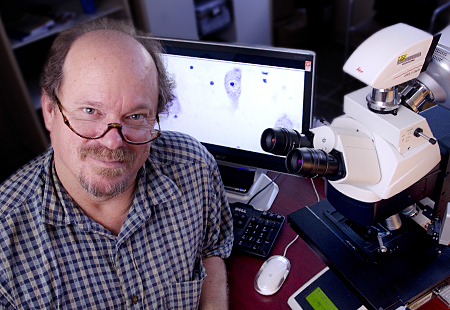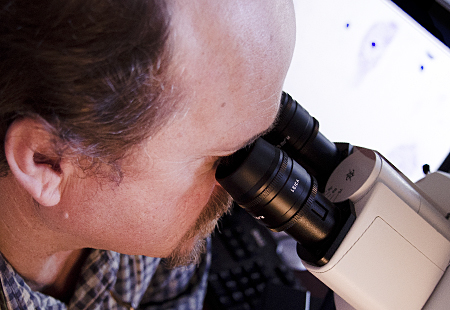USF professor helps identify brain growth problems in autism
Tampa, FL (Nov. 9, 2011)– Using innovative techniques for unbiased counting of brain cells, Peter R. Mouton, PhD, of the USF Health Byrd Alzheimer’s Institute and a diverse team of researchers have confirmed a new theory about a cause of autism.
The pivotal study, funded in part by the National Institutes of Health, confirmed that the brains of children with autism have an overabundance of brain cells produced only before birth, suggesting that autism arises from prenatal processes gone awry. Led by Eric Courchesne, PhD, at the University of California at San Diego, the study is published today in theJournal of the American Medical Association.
“Earlier studies of head circumference and overall early brain overgrowth have pointed us in this direction, but it’s been a difficult path to pursue. Only through the generous and selfless act of brain donation and the dedication of researchers to answering tough questions could such a significant scientific advance be achieved,” said Thomas R. Insel, MD, director of the National Institute of Mental Health (NIMH).

Dr. Peter Mouton of the USF Health Byrd Alzheimer’s Institute has developed innovative techniques for the unbiased counting of cells.
The study involved the blind comparison of postmortem brain tissue from seven children with autism, ages 2 to 16, with similar brain tissue from six aged-matched children who showed no evidence of neurological or psychological trouble.
“This study would not have been possible without the excellent brain material collected by Dr. Courchesne and state-of-the-art computerized approaches for unbiased stereology present at USF,” said co-lead author Mouton, a professor at the USF Health Byrd Alzheimer’s Institute and the Department of Pathology & Cell biology, University of South Florida (Tampa, FL).
The investigators honed in on the most recently evolved part of the brain, the prefrontal cortex, which comprises about one-third of the brain’s outermost layer. This choice was strongly driven by two factors. First, the prefrontal cortex plays a critical role in the regulation of the behaviors most closely associated with autism, including social communication, language production, affective personality and cognitive performance. Second, earlier brain imaging studies by Courchesne’s group at UCSD found overgrowth in the prefrontal cortex, a region populated before birth by cells (neurons), in the brains of young children with autism.
The investigators suspected an abnormal disruption of brain cells at the microscopic
level, possibly an underlying excess of brain cells. Without definitive proof, however, the
underlying cause for the enlarged prefrontal cortex in the brains of autistic children remained a mystery.
Starting in late 2009, Courchesne and colleagues teamed up with the Mouton, a NIMH grantee, who has developed computerized stereology systems to accurately and efficiently count brain cells in an unbiased manner. Using Mouton’s unbiased stereology techniques, the researchers showed that the children with autism had 67 percent more neurons in the prefrontal cortex, and significantly heavier brains for their age, compared to age-matched children with no evidence of autism.
According to the researchers, this pathological overabundance of brain cells in children with autism suggests a disruption of cellular processes that occur during prenatal life, since the affected brain cells are not produced after birth.

“Our findings strongly support the view that autism arises during prenatal brain development, rather than drugs or other environmental effects after the child is born,” said Mouton.
This study analyzed all relevant postmortem tissue available at the time, and represents the first application of the rigorous unbiased stereology method to brains from autistic children at very young ages. Efforts are underway to analyze a larger number of samples to confirm these findings and possibly identify patterns of age-related changes in autism.
Potential avenues for future investigation include studies to assess the molecular and genetic mechanisms involved in regulating early neuron production and the processes that normally manage cell pruning during late pregnancy.
Taken together, these findings open a new area of research that may lead to a better understanding of the neural changes that underlie autism, and possibly the development of novel strategies for the therapeutic management of afflicted children.
The study was funded by Autism Speaks, Cure Autism Now, The Emch Foundation, the Simons Foundation, the Thursday Club Juniors, the UCSD-NIH Autism Center of Excellence, National Institute of Mental Health (NIMH), the National Institute of Neurological Disorders and Stroke (NINDS), and the Eunice Kennedy Shriver National Institute of Child Health and Human Development.
Dr. Mouton will present the study findings Nov. 15 at a platform presentation at the Annual Meeting of the Society for Neurosciences in Washington, D.C.
Reference:
Courchesne E, Mouton PR, Calhoun ME, Semendeferi K, Ahrens-Barbeau C, Hallet MJ, Barnes CC, Pierce K. Neuron Number and Size in Prefrontal Cortex of Children with Autism. Journal of the American Medical Association. Nov. 9, 2011.
-USF Health-
USF Health is dedicated to creating a model of health care based on understanding the full spectrum of health. It includes the University of South Florida’s colleges of Medicine, Nursing, Public Health and Pharmacy, the School of Biomedical Sciences and the School of Physical Therapy and Rehabilitation Sciences; and the USF Physician’s Group. Ranked 34th in federal research expenditures for public universities by the National Science Foundation, the University of South Florida is a high impact global research university dedicated to student success.
Media contact:
Anne DeLotto Baier, USF Health Communictions, abaier@health.usf.edu or (813) 974-3300

